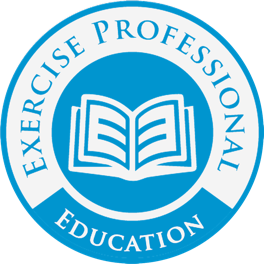News & Articles
Exercise and Muscle Terminology
Clear terminology and definitions are foundational to understanding and effective communication. Here is a list of some important terms, and their definitions, that you will encounter when perusing Exercise Professional Education content:
Exercise (n.) – a specific bodily or mental exertion, or the removal thereof, especially for the sake of training or improvement of health. Force (demand/stimulus) applied, or removed, over some time interval to, and/or from within, a sensory-motor control system, resulting in a sensory-motor solution/response, with the intention of making/maintaining a desired/specific physiological change/state.
Exercise as a philosophical and theoretical perspective regarding human physical/physiological process, contains within it an analytical model and methodologies, applied at the practical level of human experience, that contribute to wellness, physical competency, and performance.
(An exercise is perhaps a prototypically defined construct for which it is challenging to specify any one set of characteristics, each of which is by itself necessary, and all of which are jointly sufficient for an individual performing a physical action with a designated purpose (or not) to be labeled “an exercise”. An “Exercise” is not a classical concept with a clearly delineated set of necessary defining features.)
Exercise Process (v.) – bodily or mental exertions, or the removal thereof, especially for the sake of training or improvement of health, as a systematic series of bodily or mental actions, or inactions, over an extended time-period, directed to some end. aka – Exercise Continuum
Exercise Objective – making/maintaining a desired/specific physiological and/or psychological change/state. Improve/increase one or more of the following (not limited to):
- Strength,
- Cardiovascular Endurance,
- Limb/Trunk Range of Motion,
- Body Composition,
- Coordination – Motor Control,
- Resistance to Injury,
- Positive Emotional Response
Exercise Field (n.) – Any of the professions or roles that utilize exercise (as defined above) in the execution of its responsibilities when working with human health, wellness and performance.
Fit (adj.) – Physically sound, healthy, or ability to complete specific tasks.
Fitness (n.) – Good health or physical condition, especially as the result of exercise and proper nutrition
Fitness (n.) – An individual’s state or condition where their physical and mental status is such that they have the capability to initiate and perform any desired task under specified conditions.
Physical (adj.) – involving the body as distinguished from the mind or spirit
Performance (n.) – manner or quality of functioning. A reflection of an individual’s’ overall physical strength and conditioning.
Health (n.) – a person’s mental or physical condition.
Wellness (n.) – the state or condition of being in good physical and mental health.
Assessment (n.) – a specific bodily and/or mental exertion, or intentional inaction, especially for the sake of collecting information about health. Force (demand) applied, or removed, over some time interval to, and/or from within, a sensory-motor control system, resulting in a sensory-motor solution/response, with the intention of collecting data regarding current performance.
Medicine (n.) – the art or science of treating disease with drugs, curative substances, surgery, appliances or manipulations.
Non-Medical (v.) – any intervention by an individual applied to another individual that does not pertain to the science or practice of medicine, claiming, or attempting, a curative, medicinal or therapeutic property as an outcome of that intervention in treating a specific disease.
The Following Terms are defined in the frame of biomechanics of macro/gross anatomy
* Definitions used, or derived from, Miriam-Webster, Dictionary.com, Oxford Dictionary)
Active (adj.) – The cause of joint angle changes or maintenance under conditions is the muscle force development (ECC*) generated intentionally/consciously by the individual via their intrinsic central and peripheral neurological system.
Passive (adj.) – The cause of joint angle changes or maintenance under conditions is an extrinsic (external) force generated by something outside of, and other than, the individual’s intrinsic (ECC*) central and peripheral neurological system.
Voluntary (adj.) – a physical behavior done, given, or acting with one’s own free will, intention, and conscious control.
Involuntary (adj.) – a physical behavior done, given, or acting without one’s free will, intention, or conscious control, Unconscious – insensible; incapable of responding to sensory stimuli and of having subjective experiences. (Involuntary-Conscious, Involuntary-Unconscious)
Intention (n.) – the internal thought plan willfully generated by the CNS’s executive control, to do or achieve a physical action with, and within, their body.
Position (n.) – is the specified point of an object in a designated dimensional space defined, by that point’s relative distance from the designated axes of the reference frame assigned within that space.
Motion (n.) – is a change in position of an object with respect to time.
Mio – prefix from the Greek meaning; “less”.
Plio – prefix from the Greek meaning; “more”.
Iso – prefix form the Greek meaning; “same”.
Metric (n.) – from the Greek ‘metron’, meaning; “pertaining to distance”.
Length (n.) – the linear distance between two points.
Approximate (adj.) – to locate closer together in space; trigonometrically it is the terminal side moving towards the initial side with a decreasing joint angle.
Separate (adj.) – to locate farther apart in space; trigonometrically it is the terminal side moving away from the initial side with an increasing joint angle.
Joint/Limb/Trunk Angle (n.) – the angle between two body segments linked by a common joint, origin.
a. Using the trigonometric definition of angle, we define the angle components as:
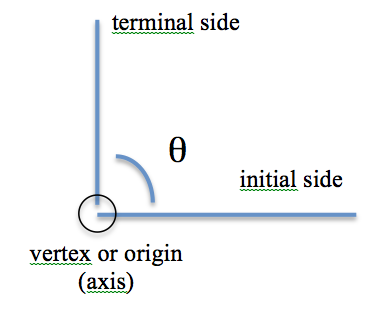
The initial side is the side that is fixed
The terminal side is the side that is moving
The angle is the space of the corner at the intersection between the initial and terminal sides and indicated with the lower case theta symbol: q above the arc symbol: )
b. A whole muscle with a single attachment point on each of the sides in a 2-D frame:
muscle image source https://www.studyblue.com/notes/note/n/9-skeletal-muscle-anatomy/deck/9570523
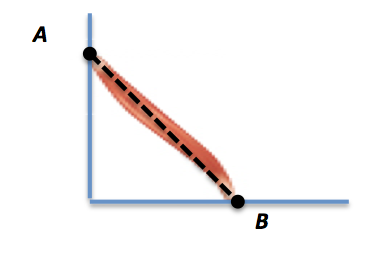
The straight-line distance between point A and B represents the linear distance
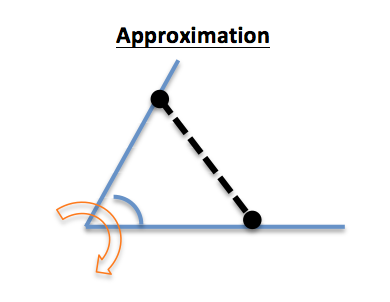
Angle decreasing = linear distance decreasing
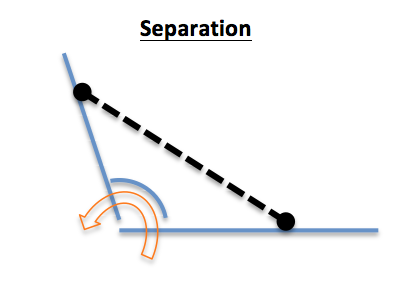
Angle increasing = linear distance increasing
Contraction (n.) – The process of becoming smaller. The process in which a muscle becomes or is made shorter and tighter. (Oxford Dictionary)
“The structural unit of contraction is the muscle fiber. The greatest amount a whole muscle can actively shorten is dependent on the maximal contraction of its contractile units.” Basmajian, 1970, WIlliams & Wilkins, Baltimore
“The term contractile element is used to describe the part of the muscle that generates tension, and it is this part that shortens and lengthens as positive or negative work is done.” Winter, David A., “Biomechanics and motor control of human movement”, 4th Ed, PG 225
This definition of contraction refers to the gross physical structure of the material geometry of muscle altering the linear distance between its attachments. It is not referring to the direction of the force vector generated by the muscle.
Here is the definition of contraction from the force vector perspective:
A muscle fiber’s functional operation – currently termed the Sliding Filament Theory – occurs via the process of excitation-contraction coupling (ECC). This generates a force vector via the interaction of the actin and myosin protein filaments located within the cell between the Z-Discs on either side of the M-Region (located at the center of the sarcomere). The force vector is created by the electromagnetic cross-bridging of interlacing actin and myosin protein structures on both sides of the M-Region. This results in a displacement of the sarcomere such that the respective Z-discs move towards the M-Region and approximate, or attempt to approximate – effectively shortening, or attempting to shorten – the fiber from its pre-ECC length. The direction of force generated by the overlapping myosin and active on both sides of the M-Region is always towards the M-Region.
image source – https://en.wikibooks.org/wiki/Structural_Biochemistry/Protein_function/Myosin

Direction of Force
Mode (n.) – the way, or manner which, a change in joint angle/muscle attachment-to-muscle attachment linear distance occurs or is experienced, expressed, or done.
Miometric (n.) Contraction shortening
Isometric (n.) Contraction sustaining
Pliometric (n.) Contraction lengthening
Configuration (n.) – the totality of macro-observable geometric arrangement of the body’s various segments and the micro unobservable arrangement of all the mechanical, chemical, and electrical information flowing within the body at any given moment.
